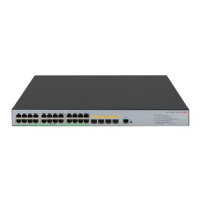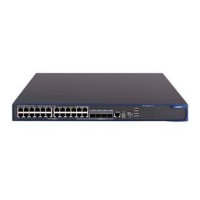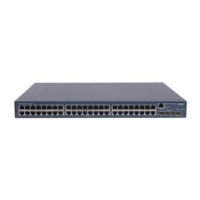46
Planning IRF topology and connections
You can create an IRF fabric in daisy chain topology or more reliable ring topology. In ring topology, the
failure of one IRF link does not cause the IRF fabric to split as in daisy chain topology. Instead, the IRF
fabric changes to a daisy chain topology without interrupting network services.
You connect the IRF member switches through IRF ports, the logical interfaces for the connections
between IRF member switches. Each IRF member switch has two IRF ports: IRF-port 1 and IRF-port 2. To
use an IRF port, you must bind a minimum of one physical port to it.
When connecting two neighboring IRF member switches, you must connect the physical ports of IRF-port
1 on one switch to the physical ports of IRF-port 2 on the other switch.
As a best practice to avoid loop topology, first complete IRF configuration and then connect the IRF
member switches.
The S5560-EI switches can provide 10-GE/40-GE IRF connections through 1/10 GE Ethernet
ports/SFP+ ports/QSFP+ ports, and you can bind several 1/10 GE Ethernet ports/SFP+ ports/QSFP+
ports to an IRF port for increased bandwidth and availability.
Figure 57 and Figure 58 sho
w the topologies of an IRF fabric made up of three S5560-30C-EI switches.
The IRF port connections in the two figures are for illustration only, and more connection methods are
available.
Figure 57 IRF fabric in daisy chain topology

